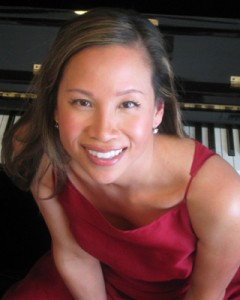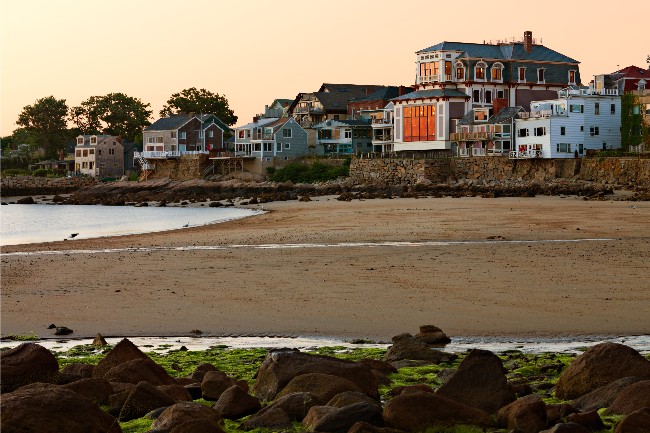Arts Feature: Water Music – Rockport Music’s Shalin Liu Performance Center
For performers and audience members alike the Shalin Liu setting is as much a part of the experience as the music. It has quickly transformed the intimate hall into a destination location for a growing number of admiring artists.
By Glenn Rifkin
It has come to be known as “The Window.” The floor-to-ceiling, glass wall behind the stage at the Shalin Liu Performance Center in Rockport, Mass. provides a spectacular view of the harbor, with boats and seagulls and the ever-shifting colors of sea and sky. At this late afternoon October performance by the Montreal-based quartet Quartango, the darkening, autumn sky served as a striking backdrop to the group’s dynamic tango-fusion offerings. As Quartango played its superb “Nieve”—the Spanish word for snow—the layered, gray stratus clouds in the background looked as if they just might open and provide an early snowstorm to accompany the evocative composition. The tall mast of an anchored sailboat swayed gently back and forth almost in synch with the music.
For performers and audience members alike, the Shalin Liu setting is as much a part of the experience as the music, and it has quickly transformed the intimate hall into a destination location for a growing number of admiring artists. Among the notable are renowned pianist Leon Fleisher; jazz legends Dave Brubeck, Chris Botti, and Ellis Marsalis; classical pianists Wendy Chen, Marc-Andre’ Hamelin and Richard Goode; singers Judy Collins, Tom Rush, Paula Cole, and Arlo Guthrie; and an ever-expanding array of lesser-known and emerging young talent. Completed in 2010, the $20 million performance venue, named for Shalin Liu, a Taiwan-born philanthropist who donated $3 million for the hall, is an acoustical gem—the sound environment created by legendary acoustics engineer Larry Kirkegaard—and has a warm, inviting interior designed by award-winning architects Alan Joslin and Deborah Epstein. Joslin and Kirkegaard teamed up in 1994 to design Seiji Ozawa Hall at Tanglewood.
Joslin deftly incorporated the Shalin Liu into Rockport’s Main Street by emulating the storefront of the 1870’s era Haskins Building that was torn down to accommodate the new hall. Local sentiment made it clear that a huge, ostentatious structure was not an option. Rockport’s ambiance as a quaint, seaside village had to be maintained. Instead, a visitor strolling past the book stores, art galleries, and coffee shops must look twice to notice he is passing a state-of-the-art concert hall. Joslin chose a design and a color palette that allowed the hall to blend seamlessly into its surroundings. From the water, the great wall of glass reflects the vaulting sky and vivid sunsets.
Epstein’s interior design, replete with an unusual, woven-wood design to emulate the waves on the water and stones imported from Vietnam to embrace the natural setting, coupled with Kirkegaard’s award-winning acoustic design to reflect and disperse the sound, created a hall that is “beautiful to the eye as well as to the ear,” according to an opening night review by James Oestreich of The New York Times. Upstairs is a spacious meeting room, also facing the harbor, that has generated additional rental revenue with private receptions and other events.
“It is the most beautiful hall in which I’ve ever performed,” said Wendy Chen, the virtuoso, classical pianist, who has played either solo or in a chamber music ensemble in many of the world’s most prominent venues. “It is intimate and awe-inspiring. As a performer, it brings out a different inspiration for my music and performance. If you start your show early enough to play when the sun is setting, it just so breathtaking and profound. It really is a jewel for the town.”
Paula Cole, the popular singer-songwriter, grew up in Rockport and has already played the Shalin Liu nine times. She noted that Rockport has always been a creative community and an artistic outpost and the Shalin Liu is elevating the town’s profile.
“I used to go to The Madras Shop, a bargain clothing store, that sat in that space,” she recalled. “The Shalin Liu provided a much-needed facelift to this beautiful community and it’s attracting more and more interesting people. The stage feels heavenly, the piano is heaven. Everything was thoughtfully built, even the Green Room for artists is wonderful. The place is just loaded with great vibes.”
Ironically, what makes the Shalin Liu so attractive may be the same reason it remains a reasonably well-kept secret for Boston-area concert goers. Rockport, the scenic, seacoast town and former artist’s colony, is at the tip of Cape Ann, 40 miles north of Boston. And though it has long been a tourist Mecca, Rockport, as Tony Beadle, executive director of Rockport Music, says, “is the end of the line. It’s not on the way to anyplace else so you can’t come here for a concert and then drive on to Kittery, Maine or some other destination.”
Nonetheless, Rockport is enticing enough on its own. The perception is that the town is about quaint art galleries and a summer stroll down Bearskin Neck to buy a t-shirt and lobster roll. Rockport as a musical destination is not yet a fully-evolved perception despite the fact that the Rockport Chamber Music Festival is now in its 31st year. The few quality restaurants in town shut down through the winter, which makes dinner and a concert more difficult to attain (although neighboring Gloucester has a variety of quality eateries). The marketing challenge therefore is to find a way to expand Rockport Music’s audience beyond the Cape Ann and North Shore communities and continue to build a dedicated and loyal fan base across New England. So far, so good. From its opening season, when it drew just 5,000, the Shalin Liu is now drawing 25,000 for the Rockport Music season, which is impressive given that the diminutive hall seats just 330 patrons. In order to stay vibrant and viable, Beadle must finds ways to sustain and increase subscriptions and keep the doors open on more and more revenue-generating days and nights.
From its roots, which is the Rockport Chamber Music series, Rockport Music’s mission has been to “test new genres” in order to draw a wider audience, according to Beadle. The hall is now hosting not just chamber music but an array of classical offerings, jazz, blues, folk, and world music, as Quartango demonstrated. HD broadcasts of the Metropolitan Opera on screen and a film series have also found an audience. Beadle said he and the board are considering adding comedy to the lineup if the economics are attractive. He booked The Amazing Kreskin, which raised a few eyebrows, but proved to be a hit with the audience.
True to its mission, Rockport Music has an ambitious education and outreach program for students and adults, which includes a series of free concerts on Sunday mornings. Without an endowment, the Shalin Liu depends heavily on fundraising to supplement ticket sales and other income streams. Jazz on the Rocks, a concert featuring jazz star Chris Botti in November, combines the music with a live auction and reception in order to raise needed funds. In the long run, it is big names like Botti that attract attention and build a reputation, Beadle said. And due to its limited seating capacity and restrained ticket prices, the Shalin Liu cannot afford the James Taylors or Elton Johns of the world. It remains a pitched battle against economic realities.
But that doesn’t mean it is offering second-rate talent.
“The core of our branding is the idea that whomever appears at the Shalin Liu, regardless of the musical genre or whether you’ve heard of them or not, is going to be of reliably high quality,” says Richard Tennant, a Rockport-based cartoonist and member of the Rockport Music board. “We hope to build trust from our patrons by being known as a venue where every performance is worth attending. Quality musicianship is the hallmark of our brand.”
For music lovers, this means that smaller venues such as Shalin Liu are welcome tour stops for those who are “famous to a few” or artists with loyal if limited followings. For example, Tamir Hendelman, an Israeli-born, Los Angeles-based jazz pianist who has accompanied Barbra Streisand in concert, wowed the Shalin Liu crowd last January. John Jorgenson, whose gypsy jazz calls to mind Django Reinhardt, blew the roof off the place this past summer.
David Deveau, the pianist and MIT faculty member, has been Rockport Music’s artistic director since 1995, and his task has been to expand the hall’s audience by expanding the classical musical menu. For the Rockport Chamber Music Festival, the five-week summer highlight, Deveau has attracted the likes of pianists Goode, Hamelin, Chen, Garrick Ohlsson, along with the Brentano, Borromeo, Julliard and St. Lawrence string quartets, and violinists Christian Tetzlaff and Midori.
Deveau’s strategy is working well thus far, Beadle said. The number of households buying tickets has jumped from 1,500 in the first year to 6,000 during this third season. “Our reach has gone from the local community and Cape Ann to Boston and the western suburbs,” Beadle said. Operating at about 90% capacity, the Shalin Liu remains a work in progress, trying out new genres and exploring ways to get people into the hall. Direct mail and email campaigns form the core of the marketing and advertising strategy and word of mouth remains a powerful tool in bringing in new customers. “We work closely with the tourism bureau and the local chamber of commerce,” Beadle said. “But it’ s a matter of population density. If this hall was in Cambridge, it would be going seven nights a week.”
Ironically, the hall’s signature glass wall behind the stage has itself become a source of controversy, minor though it may be. Due to the acoustics of amplified music and the reflecting nature of the glass, some performers choose to have the curtain closed behind them. Some patrons, eager to experience the awe-inspiring backdrop, are disappointed when the window is not visible. “We never anticipated this would be a big issue,” Beadle said. “We never promised it would be open all the time and it is really up to the performers if they want it closed. They make a decision when they do a sound check.”
On bright, summer afternoons, however, patrons in the orchestra seats sometimes don sunglasses to control the glare. “You can never make everything perfect,” Beadle sighs. But in truth, the complaints are minimal.
“Every hall, every performance center brings in an acoustician and hopes for all things to line up just right,” said pianist Chen. “There are always complainers out in the world but you really can’t find fault with this place. From the stage, everything sounds ringing, sonorous and beautiful. I haven’t sat in the audience but you can sense how it projects, how it sounds from Row Z. And you get a sense that it is an all encompassing beauty.”
Glenn Rifkin is a veteran journalist and author who has covered business for many publications including The New York Times for nearly 30 years. He has written about music, film, theater, food and books for ArtsFuse. His new book, Future Forward: Leadership Lessons from Patrick McGovern, the Visionary Who Circled the Globe and Built a Technology Media Empire, will be published by McGraw-Hill in September.



